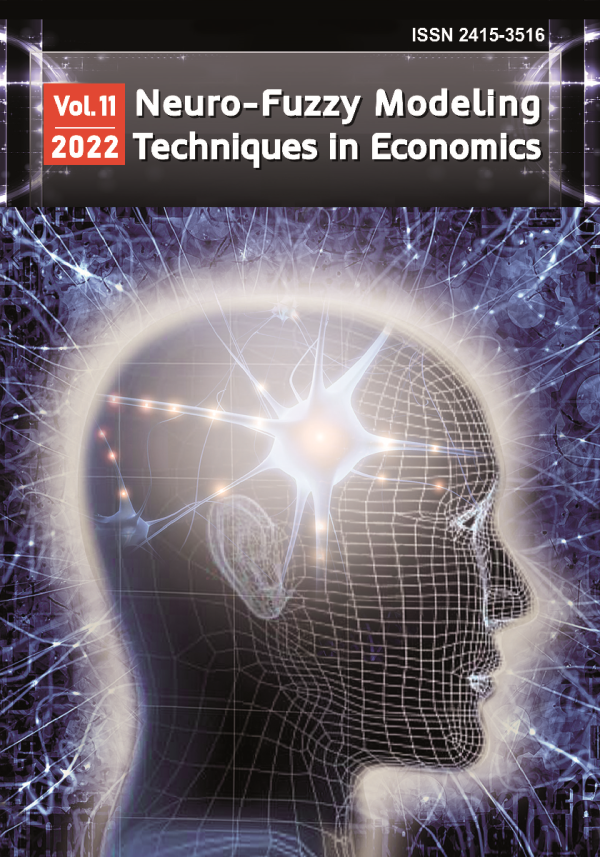
Neuro-Fuzzy Modeling Techniques in Economics
ISSN 2415-3516
Enterprise strategies stratification based on the fuzzy matrix approach
DOI:
10.33111/nfmte.2022.124
Анотація:
Abstract: A stratification model of enterprise strategies on the basis of tools of fuzzy set theory and fuzzy matrix analysis was developed. Classic methods of strategic diagnostics of the company, fuzzy methods of multi-criteria evaluation (Fuzzy Extension of Simplified Best-Worst Method (Fuzzy SBWM) and Fuzzy SAW) and fuzzy matrices were used to achieve the goals set. The classic Quantitative Strategic Planning Matrix (QSPM) criteria were used to make a strategic choice. The developed model is based on defined term sets of expert linguistic assessments (8-level – for determining the importance of SWOT factors and 7-level – for evaluating strategic alternatives) with their subsequent conversion into fuzzy numbers with triangular membership functions. The Fuzzy SBWM was used to calculate the importance of SWOT factors for each area of analysis, and the Fuzzy SAW method was used to determine the fuzzy integral evaluations of strategic alternatives for these areas. Strategic alternatives were positioned in fuzzy matrices “O – T” and “S – W” using the α-section. Stratification of strategies is based on the superposition of fuzzy matrices and the application of production rules for the obtained integral fuzzy estimates of strategic alternatives. The framework has been developed in the Excel software application to carry out calculations according to this approach, which contains the following components: a block for entering linguistic expert information (for each direction of analysis and evaluation of strategic alternatives) and transforming these linguistic data into fuzzy numbers in a triangular form, a block for calculating factor weighting coefficients by best and worst approaches and their fuzzy integral values, a block for calculating fuzzy values of strategies in the directions of “opportunities-threats” and “strengths-weaknesses” at different values of α-section, a block of production rules for stratification of strategies to carry out calculations according to this approach. The methodical approach enables the top management of the enterprise to determine the weighting coefficients of the SWOT factors and identify the list of preferable strategic alternatives for implementation.
Ключові слова:
Key words: fuzzy set theory, fuzzy matrix analysis, linguistic variable, term set, strategy stratification, fuzzy SBWM, fuzzy SAW method
УДК:
UDC:
JEL: C51 C63 D04
To cite paper
In APA style
Balan, V. (2022). Enterprise strategies stratification based on the fuzzy matrix approach. Neuro-Fuzzy Modeling Techniques in Economics, 11, 124-156. http://doi.org/10.33111/nfmte.2022.124
In MON style
Балан В. Enterprise strategies stratification based on the fuzzy matrix approach. Нейро-нечіткі технології моделювання в економіці. 2022. № 11. С. 124-156. http://doi.org/10.33111/nfmte.2022.124 (дата звернення: 03.01.2026).
With transliteration
Balan, V. (2022) Enterprise strategies stratification based on the fuzzy matrix approach. Neuro-Fuzzy Modeling Techniques in Economics, no. 11. pp. 124-156. http://doi.org/10.33111/nfmte.2022.124 (accessed 03 Jan 2026).
 # 11 / 2022
# 11 / 2022
Download Paper

951
Views
155
Downloads
1
Cited by
- Abraham, S. (2012). Strategic Planning: A Practical Guide for Competitive Success (2nd ed.). Emerald Publishing.
- Acur, N., & Englyst, L. (2006). Assessment of strategy formulation: how to ensure quality in process and outcome. International Journal of Operations & Production Management, 26(1), 69-91. https://doi.org/10.1108/01443570610637021
- Amiri, M., Tabatabaei, M.H., Ghahremanloo, M., Keshavarz-Ghorabaee, M., Zavadskas, E.K., & Antucheviciene, J. (2020). A new fuzzy approach based on BWM and fuzzy preference programming for hospital performance evaluation: A case study. Applied Soft Computing, 92, Article 106279. https://doi.org/10.1016/j.asoc.2020.106279
- Ansoff, I. (1979). Strategic Management. Palgrave Macmillan. https://doi.org/10.1007/978-1-349-02971-6
- Balan, V. (2020). Nechitka model otsiniuvannia ta vyboru stratehii na osnovi modyfikatsii kvantytatyvnoi matrytsi stratehichnoho planuvannia [Fuzzy model of evaluation and selection of strategies based on modification of the quantitative strategic planning matrix]. Problemy systemnoho pidkhodu v ekonomitsi (Problems of systemic approach in the economy), 3(77), 85-93. https://doi.org/10.32782/2520-2200/2020-3-12 [in Ukrainian]
- Balan, V. (2020). Zastosuvannia dynamichnoho nechitkoho SPACE-analizu dlia formuvannia stratehii pidpryiemstva [Application of dynamic fuzzy SPACE-analysis for forming enterprise strategies]. Neiro-Nechitki Tekhnolohii Modelyuvannya v Ekonomitsi (Neuro-Fuzzy Modeling Techniques in Economics), 9, 26-64. http://doi.org/10.33111/nfmte.2020.026 [in Ukrainian]
- Chang, P., Huang, L., & Lin, H. (2000). The fuzzy Delphi method via fuzzy statistics and membership function fitting and an application to the human resources. Fuzzy Sets and Systems, 112(3), 511-520. https://doi.org/10.1016/S0165-0114(98)00067-0
- David, F.R. (2015). Strategic management: concepts and cases – a competitive advantage approach. Pearson Education.
- David, M.E., David, Fred R., & David, Forest R. (2016). The quantitative strategic planning matrix: a new marketing tool. Journal of Strategic Marketing, 25(4), 342-352. http://dx.doi.org/10.1080/0965254X.2016.1148763
- Day, G.S. (1994). Evaluating Strategic Alternatives. In L. Fahey, & M.R. Randall (Eds.), The Portable MBA in Strategy (pp. 297-317). John Wiley & Sons, Inc.
- Dong, J., Wan, S., & Chen, S.-M. (2021). Fuzzy best-worst method based on triangular fuzzy numbers for multi-criteria decision-making. Information Sciences, 547, 1080-1104. https://doi.org/10.1016/j.ins.2020.09.014
- Fahey, L., & Randall, R.M. (2001). The Portable MBA in Strategy. John Wiley & Sons, Inc.
- Fleisher, K., & Bensoussan, B. (2002). Strategic and Competitive Analysis: Methods and Techniques for Analyzing Business Competition. Pearson College Div.
- Fouladgar, M., Yazdani-Chamzini, A., & Yakhchali, S. (2011). A new methodology for prioritizing mining strategies. International Journal of Innovation, Management and Technology, 2(4), 342-347. http://www.ijimt.org/show-32-603-1.html
- Friedrichsen, M., Zarea, H., Tayebi, A., & Abad, F.A.S. (2018). Competitive strategies of knowledge and innovation commercialization: a unified SWOT and Fuzzy AHP approach. AD-minister, 30, 45-72. https://doi.org/10.17230/ad-minister.30.3
- Gaonkar, R.S.P., Verma, A.K., & Srividya, A. (2008). Exploring Fuzzy Set Concept in Priority Theory for Maintenance Strategy Selection Problem. The International Journal of Applied Management and Technology, 6(3), 131-142. https://core.ac.uk/works/125807675
- Glueck, W.F., & Jauch, L.R. (1984). Strategic Management and Business Policy. McGraw-Hill.
- Grant, R.M. (2021). Contemporary Strategy Analysis (11th ed.). Wiley.
- Guo, S., & Qi, Z. (2021). A Fuzzy Best-Worst Multi-Criteria Group Decision-Making Method. IEEE Access, 9, 118941–118952. https://doi.org/10.1109/ACCESS.2021.3106296
- Guo, S., & Zhao, H. (2017). Fuzzy best-worst multi-criteria decision-making method and its applications. Knowledge-Based Systems, 121, 23-31. https://doi.org/10.1016/j.knosys.2017.01.010
- Hafezalkotob, A., & Hafezalkotob, A. (2017). A novel approach for combination of individual and group decisions based on fuzzy best-worst method. Applied Soft Computing, 59, 316-325. https://doi.org/10.1016/j.asoc.2017.05.036
- Hamal, S., Sennaroglu, B., & Arıoğlu, M.Ö. (2020). Marketing Strategy Selection Using Fuzzy Analytic Network Process. In C. Kahraman, S. Cevik Onar, B. Oztaysi, I. Sari, S. Cebi, & A. Tolga (Eds.), Advances in Intelligent Systems and Computing: Vol. 1197. Intelligent and Fuzzy Techniques: Smart and Innovative Solutions (pp. 1008-1014). Springer. https://doi.org/10.1007/978-3-030-51156-2_117
- Hussey, D.E. (1998). Strategic Management. From theory to implementation. Butterworth-Heinemann.
- Hussey, D.E. (1999). Strategy and Planning: A Manager’s Guide. Wiley.
- Jeyaraj, K.L., Muralidharan, C., Senthilvelan, T., & Deshmukh, S.G. (2012). A hybrid business strategy selection process for a Тextile company using SWOT and fuzzy ANP – a case study. International Journal of Management, 3(2), 124-143. https://iaeme.com/Home/article_id/IJM_03_02_012
- Johnson, G., Scholes, K., & Whittington, R. (2008). Exploring corporate strategy (8th ed.). Financial Times Prentice Hall.
- Kokoç, M., Ersöz, S., & Aktepe, A. (2020) A Fuzzy Inference System Proposal for Selecting Marketing Strategy. International Journal of Eastern Anatolia Science Engineering and Design, 2(1), 1-21. https://dergipark.org.tr/en/pub/ijeased/issue/50819/653763
- Kotler, Ph., Berger, R. & Bickhoff, N. (2016). The Quintessence of Strategic Management: What You Really Need to Know to Survive in Business. Springer.
- Kozlovskyi, S., Butyrskyi, A., Poliakov, B., Bobkova, A., Lavrov, R., & Ivanyuta, N. (2019). Management and comprehensive assessment of the probability of bankruptcy of Ukrainian enterprises based on the methods of fuzzy sets theory. Problems and Perspectives in Management, 17(3), 370–381. http://dx.doi.org/10.21511/ppm.17(3).2019.30
- Kuzu, Ö.H. (2020). Strategy Selection in the Universities via Fuzzy AHP Method: A Case Study. International Journal of Higher Education, 9(2), 107-117. https://doi.org/10.5430/ijhe.v9n2p107
- Laczkowski, K., Rehm, W., & Warner, B. (2018). Seeing your way to better strategy. McKinsey & Company. https://www.mckinsey.com/capabilities/strategy-and-corporate-finance/our-insights/seeing-your-way-to-better-strategy#/
- Lampel, J., Mintzberg, H., Quinn, J.B., & Ghoshal, S. (2014). The Strategy Process: Concepts, Contexts, Cases (5th ed.). Trans-Atlantic Publications.
- Leekwijck, W., & Kerre, E.E. (1999). Defuzzification: criteria and classification. Fuzzy Sets and Systems, 108(2), 159-178. https://doi.org/10.1016/S0165-0114(97)00337-0
- Leleur, S. (2012). Complex Strategic Choices. Applying Systemic Planning for Strategic Decision Making. Springer London. https://doi.org/10.1007/978-1-4471-2491-7
- Matviychuk, A. (2010). Bankruptcy prediction in transformational economy: discriminant and fuzzy logic approaches. Fuzzy economic review, 15(1), 21–38. https://doi.org/10.25102/fer.2010.01.02
- Mohaghar, A., Fathi, M.R., Zarchi, M.K., & Omidian, A. (2012). A Combined VIKOR - Fuzzy AHP Approach to Marketing Strategy Selection. Business Management and Strategy, 3(1), 13-27. https://doi.org/10.5296/bms.v3i1.957
- Mohammadi, A., Mohammadi, Ab., Zarifpayam, S.V., & Mohammadi, M. (2011). Presentation of Fuzzy Models of EFE, IFE and QSPM. Australian Journal of Basic and Applied Sciences, 5(12), 1173-1179. https://www.ajbasweb.com/old/ajbas/2011/December-2011/1173-1179.pdf
- Nasab, H.H., & Milani, A.S. (2012). An improvement of quantitative strategic planning matrix using multiple criteria decision making and fuzzy numbers. Applied Soft Computing, 12(8), 2246-2253. https://doi.org/10.1016/j.asoc.2012.03.010
- Rezaei, J. (2015). Best-worst multi-criteria decision-making method. Omega, 53, 49-57. https://doi.org/10.1016/j.omega.2014.11.009
- Rezaei, J. (2016). Best-worst multi-criteria decision-making method: Some properties and a linear model. Omega, 64, 126-130. https://doi.org/10.1016/j.omega.2015.12.001
- Rumelt, R. (1980). The Evaluation of Business Strategy. In W. F. Glueck (Ed.), Business Policy and Strategic Management (3rd ed., pp. 359-367). McGraw-Hill.
- Sagar, M. K., Jayaswal, P., & Kushwah, K. (2013). Exploring Fuzzy SAW Method for Maintenance Strategy Selection Problem of Material Handling Equipment. International Journal of Current Engineering and Technology, 3(2), 600-605. https://inpressco.com/exploring-fuzzy-saw-method-for-maintenance-strategy-selection-problem-of-material-handling-equipment/
- Thompson, A.A., & Strickland, A.J. (2003). Strategic Management: Concepts and Cases (13th ed.). McGraw Hill.
- Wheelen, T.L., Hunger, J.D., Hoffman, A.N., & Bamford, C.E. (2018). Strategic Management and Business Policy. Globalization, Innovation, and Sustainability (15th ed.). Pearson Education Limited.
- Zadeh, L.A. (1978). Fuzzy Sets as a Basis for a Theory of Possibility. Fuzzy Sets and Systems, 1(1), 3-28. https://doi.org/10.1016/0165-0114(78)90029-5

